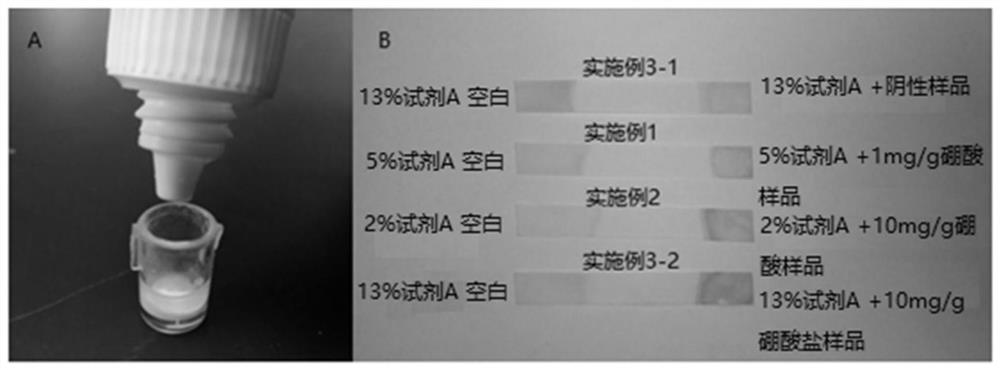Detection method of boric acid and/or borate
A detection method and borate technology, applied in the field of chemical analysis, can solve the problems of cumbersome processing, drying, heating, etc., and achieve the effects of simple and convenient operation, easy results, and short use time
- Summary
- Abstract
- Description
- Claims
- Application Information
AI Technical Summary
Problems solved by technology
Method used
Image
Examples
Embodiment 1
[0032] Take 5 g of dry hydrogen chloride and dissolve in 100 g of anhydrous methanol to obtain reagent A with a mass concentration of 5%.
[0033] Take 20 mg of 1 mg / g boric acid sample into a test tube, add 2 drops of reagent A dropwise, and shake to obtain a mixture. Pipette 1 drop of the mixture onto one end of the turmeric test paper, and at the same time add 1 drop of reagent A to the other end of the turmeric test paper as a blank. Immediately after adding the mixture, the turmeric test paper presents as figure 1 The results shown.
[0034] from figure 1 It can be seen that the turmeric test paper did not appear red after the reagent A was added dropwise, but the turmeric test paper immediately appeared light red after the mixture was added dropwise, indicating that this detection method can quickly detect boric acid and determine whether boric acid is contained in the sample to be tested.
Embodiment 2
[0036] Take 2 g of dry hydrogen chloride and dissolve in 100 g of absolute ethanol to obtain reagent A with a mass concentration of 2%.
[0037] Take 40 mg of 10 mg / g boric acid sample into a test tube, add 3 drops of reagent A dropwise, and shake to obtain a mixture. Pipette 1 drop of the mixture onto one end of the turmeric test paper, and at the same time add 1 drop of reagent A to the other end of the turmeric test paper as a blank. Immediately after adding the mixture, the turmeric test paper presents as figure 1 The results shown.
[0038] from figure 1 It can be seen that the turmeric test paper did not appear red after the reagent A was added dropwise, but the turmeric test paper immediately appeared red after the mixture was added dropwise. Simultaneously compared with Example 1, the redness of this embodiment becomes darker, which should be related to the concentration of boric acid, reflecting that the detection method of the present invention can quickly compare...
Embodiment 3
[0040] Take 13 g of dry hydrogen chloride and dissolve in 100 g of anhydrous methanol to obtain reagent A with a mass concentration of 13%.
[0041] Take 80 mg of negative sample into a test tube, add 8 drops of reagent A dropwise, and shake to obtain a mixture. Pipette 1 drop of the mixture onto one end of the turmeric test paper, and at the same time add 1 drop of reagent A to the other end of the turmeric test paper as a blank. Immediately after adding the mixture, the turmeric test paper presents as figure 1 The results shown ( figure 1 Example 3-1).
[0042] In addition, 80 mg of 10 mg / g borate sample was taken into a test tube, 8 drops of reagent A were added dropwise, and the mixture was obtained by shaking. Pipette 1 drop of the mixture onto one end of the turmeric test paper, and at the same time add 1 drop of reagent A to the other end of the turmeric test paper as a blank. Immediately after adding the mixture, the turmeric test paper presents as figure 1 The re...
PUM
 Login to View More
Login to View More Abstract
Description
Claims
Application Information
 Login to View More
Login to View More - R&D
- Intellectual Property
- Life Sciences
- Materials
- Tech Scout
- Unparalleled Data Quality
- Higher Quality Content
- 60% Fewer Hallucinations
Browse by: Latest US Patents, China's latest patents, Technical Efficacy Thesaurus, Application Domain, Technology Topic, Popular Technical Reports.
© 2025 PatSnap. All rights reserved.Legal|Privacy policy|Modern Slavery Act Transparency Statement|Sitemap|About US| Contact US: help@patsnap.com

